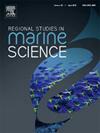Biological efficacy of iron for marine macroalgae
IF 2.1
4区 环境科学与生态学
Q3 ECOLOGY
引用次数: 0
Abstract
Herein, a chemical washing method for iron (Fe) plaques on the macroalgal cell surface and the biological effectiveness of Fe for macroalgal growth is reported. A 3-component complex of Ti, citric acid, and EDTA was used as the chemical washing agent. Iron (<0.03–10 µmol), nutrients, organic ligands, and light intensity (1.0–100 µmol m–2s–1) were controlled during macroalgal culture tests. The biological effectiveness of Fe plaques and organic Fe complexes for macroalgal growth was analyzed using photosynthetic activity. The results suggest that the higher the stability constant of organic ligands in the medium (28.5 for Fe-DTPA), the more the Fe uptake by macroalgae is inhibited, leading to lower intracellular Fe (2.20 mmol g–1 for DTPA at Fe:L = 1:500) and decreased photosynthetic activity (0.44 for DTPA at Fe:L = 1:500); a moderate ability to form complexes with Fe (16.5 for Fe-MGDA) promotes Fe uptake. In addition, trace element contents of the macroalgae were monitored throughout the year, and seasonal fluctuations in the sea area was conducted by supplying Fe from autumn in Mashike Bay, Hokkaido, Japan. In the monthly survey of Grateloupia divaricata, whole-cell Fe content fluctuated (37.9–280.1 mg kg–1), with a tendency to decrease from May to September and increase again in October. The same tendency was confirmed for other trace elements like aluminium (27.2–470.9 mg kg–1) and manganese (3.1–12.9 mg kg–1). Furthermore, the demand for nutrients decreased as growth slowed after the peak season in spring, and Fe content increased in October as most of the plants died and the relative biomass declined. In contrast, arsenic (10.0–18.0 mg kg–1) and cadmium (0.22–0.50 mg kg–1), which are highly toxic to living organisms, tended to increase gradually from May to October. This study might be a new insight to formulate appropriate measures for environmental conservation in coastal areas.
铁对海洋大型藻类的生物功效
本文报道了大藻细胞表面铁(Fe)斑块的化学清洗方法以及铁对大藻生长的生物学效果。采用钛、柠檬酸和EDTA三组分配合物作为化学清洗剂。在大藻培养试验中,控制铁(0.03-10µmol)、营养物质、有机配体和光照强度(1.0-100µmol m-2s-1)。利用光合活性分析了铁斑块和有机铁配合物对大藻生长的生物学效果。结果表明,培养基中有机配体的稳定常数越高(Fe-DTPA为28.5),大藻对铁的吸收就越受抑制,导致细胞内铁含量降低(Fe:L = 1:500时,DTPA为2.20 mmol g-1),光合活性降低(Fe:L = 1:500时,DTPA为0.44);与铁形成络合物的适度能力(Fe- mgda为16.5)促进了铁的吸收。此外,对日本北海道Mashike湾的大型藻类进行了全年微量元素含量监测,并从秋季开始补给铁,进行了海域的季节性波动。各月调查中,全细胞铁含量呈波动趋势(37.9 ~ 280.1 mg kg-1), 5 ~ 9月呈下降趋势,10月又呈上升趋势。其他微量元素如铝(27.2-470.9 mg kg-1)和锰(3.1-12.9 mg kg-1)也有同样的趋势。春季植物生长高峰期过后,对养分的需求随着生长速度的减慢而减少;10月份,铁含量随着植株的大部分死亡和相对生物量的下降而增加。而对生物剧毒的砷(10.0 ~ 18.0 mg kg-1)和镉(0.22 ~ 0.50 mg kg-1)在5 ~ 10月间呈逐渐增加的趋势。本研究为制定合理的沿海地区环境保护措施提供了新的思路。
本文章由计算机程序翻译,如有差异,请以英文原文为准。
求助全文
约1分钟内获得全文
求助全文
来源期刊

Regional Studies in Marine Science
Agricultural and Biological Sciences-Ecology, Evolution, Behavior and Systematics
CiteScore
3.90
自引率
4.80%
发文量
336
审稿时长
69 days
期刊介绍:
REGIONAL STUDIES IN MARINE SCIENCE will publish scientifically sound papers on regional aspects of maritime and marine resources in estuaries, coastal zones, continental shelf, the seas and oceans.
 求助内容:
求助内容: 应助结果提醒方式:
应助结果提醒方式:


